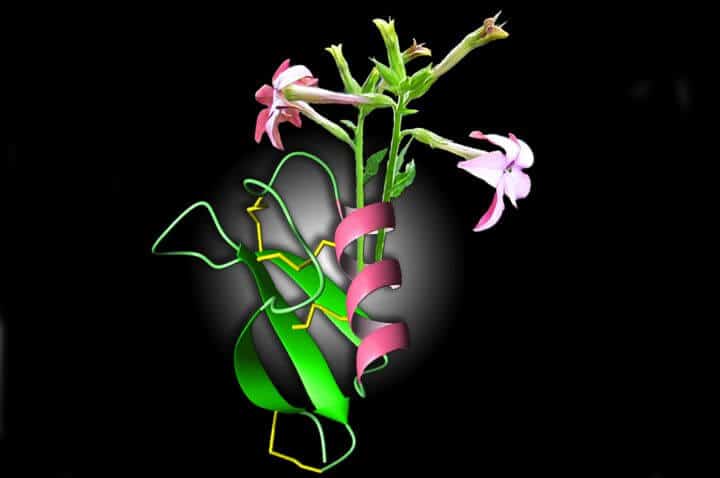La Trobe University research has revealed a tobacco plant’s natural defence mechanisms could be harnessed to kill cancer cells in the human body.
Scientists at the La Trobe Institute for Molecular Science have identified that a molecule occurring in the flower of the plant that fights off fungi and bacteria also has the ability to identify and destroy cancer.
The defence molecule, called NaD1, works by forming a pincer-like structure that grips onto lipids present in the membrane of cancer cells and rips it open, causing the cell to expel its contents and explode.
The results are published in the journal eLife today.
Lead investigator Dr Mark Hulett said the discovery has potential for use in cancer treatment.
‘There is some irony in the fact that a powerful defence mechanism against cancer is found in the flower of a species of ornamental tobacco plant, but this is a welcome discovery, whatever the origin,’ Dr Hulett said.
‘The next step is to undertake pre-clinical studies to determine what role NaD1 might be able to play in treating cancer. The preclinical work is being conducted by the Melbourne biotechnology company Hexima. So far the preliminary trials have looked promising.
‘We are confident there is potential for this discovery to translate to therapeutic use in humans.
‘One of the biggest issues with current cancer therapies is that the effect of the treatment is indiscriminate,’ Dr Hulett said. ‘In contrast, we’ve found NaD1 can target cancerous cells and has little or no effect on those that are healthy.’
Dr Hulett said scientists have known for some time about the molecules that form the first line of defence against microbial invasion in all plant and animal species. Until now nobody has known how the molecules actually did their job.
‘We’ve discovered the workings of this universal defence process, which could also potentially be harnessed for the development of other therapeutic applications, including antibiotic treatment for microbial infections,’ he said.
The discovery is the result of a multidisciplinary collaboration between scientists from Dr Hulett’s laboratory in cancer biology and Dr Marc Kvansakul’s laboratory in structural biology at La Trobe University. The research utilised equipment at the Melbourne-based Australian Synchrotron and was supported by Hexima Ltd, Balmoral Pty Ltd and the Australian Research Council. The research paper is available online.



Everybody knows that tobacco is not famous for its advantages in medicine but rather the negative effects it has on the human body. I have been taught that any form of tobacco is bad for you and that is why I find this particular article very interesting. This is an alternative method to cure cancer rather than the methods used now which have very bad side effects. According to another article (http://www.sciencedaily.com/releases/2009/03/090318211236.htm) the properties tobacco possess to cure cancer is not the only medicinal properties. Genetically modified tobacco are able to produce chemicals are able to treat autoimmune disorders and diabetes. According to another article (http://readynutrition.com/resources/it-aint-just-for-smoking-known-but-beneficial-uses-for-tobacco_27082010/ ) tobacco is also a treatment for mental diseases like ADD/ADHD and schizophrenia. According to the article, patients suffering from Alzheimer’s and dementia may also benefit from nicotine. It seems like tobacco has many more properties that are able to help people than what people would expect. Tobacco could be the key ingredient for the treatment of many diseases that affect millions of people in the near future.
It is amazing how a cause of a disease could actually lead to the absence of that disease. even though this is fascinating, further investigations should be done to gain more knowledge on this molecule. it is a good thing that it destroys the cancerous cells without harming healthy cells but what else does this molecule do when transferred into the human body, any side effects or long term disabilities. who knows we might be unleashing a stronger version of it. with more information gained and results being positive this could lead to an expansion on cancer treatments. with a serious condition like cancer we cannot afford any mistakes no matter how good the information at hand is, until information is well validated up to roughly 90% everything we have at the moment can be seen as potential steps which might lead to our asnswer.
This article is very interesting. It is extremely ironic that a cure for cancer may lie in the plant that many people associate with causing cancer. This breakthrough could lead to significant improvements in the way in which cancer is treated. The fact that the NaD1 molecule specifically targets cancer cells leaving normal cells unharmed means that the damage to a person’s health could be greatly reduced when compared to conventional chemotherapy and radiation treatments, which affect both cancerous and normal cells.
This treatment could be potentially be used in conjunction with other recently developed cancer treatment methods, such as that of using iron oxide nanoparticles and magnets, which kill cancer cells using heat (as mentioned in a previous blog). The need to use chemotherapy and radiotherapy could therefore be removed, giving many positive implications such as fewer side effects and possibly decreased recovery time
In a world where there is increasing antibiotic resistance, the discovery of new treatments for bacterial infections is always beneficial. The fact that the tobacco plant may have a use in antibiotics could provide an alternate defense against resistant strains of bacteria.
The tobacco plant seems as though it has the potential for a broad range of biomedical applications. It will be interesting to learn of any developments in the future.